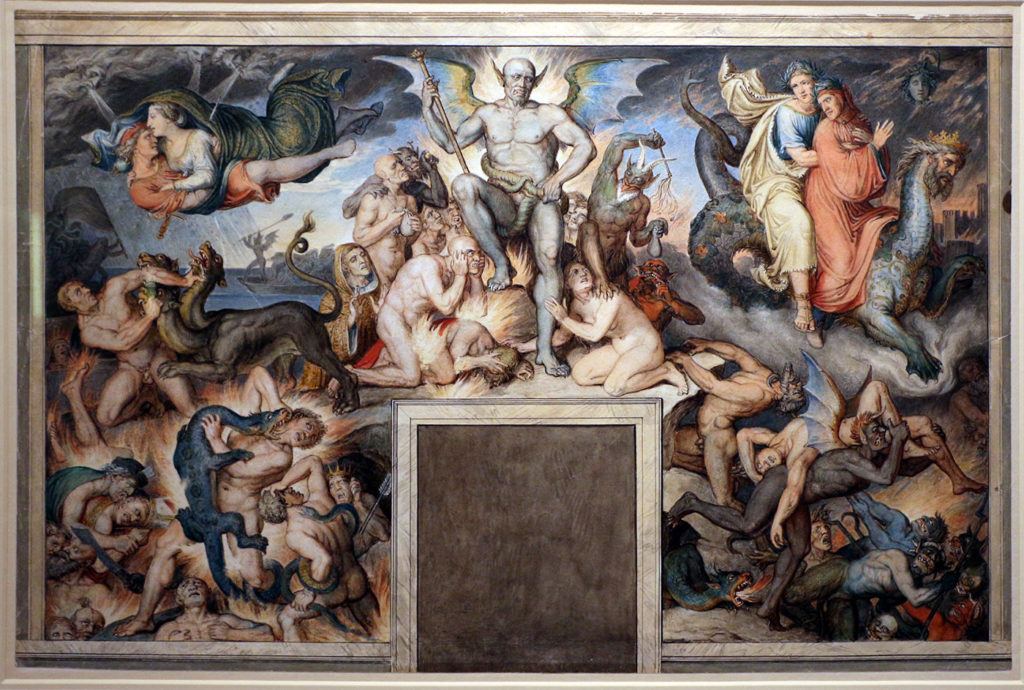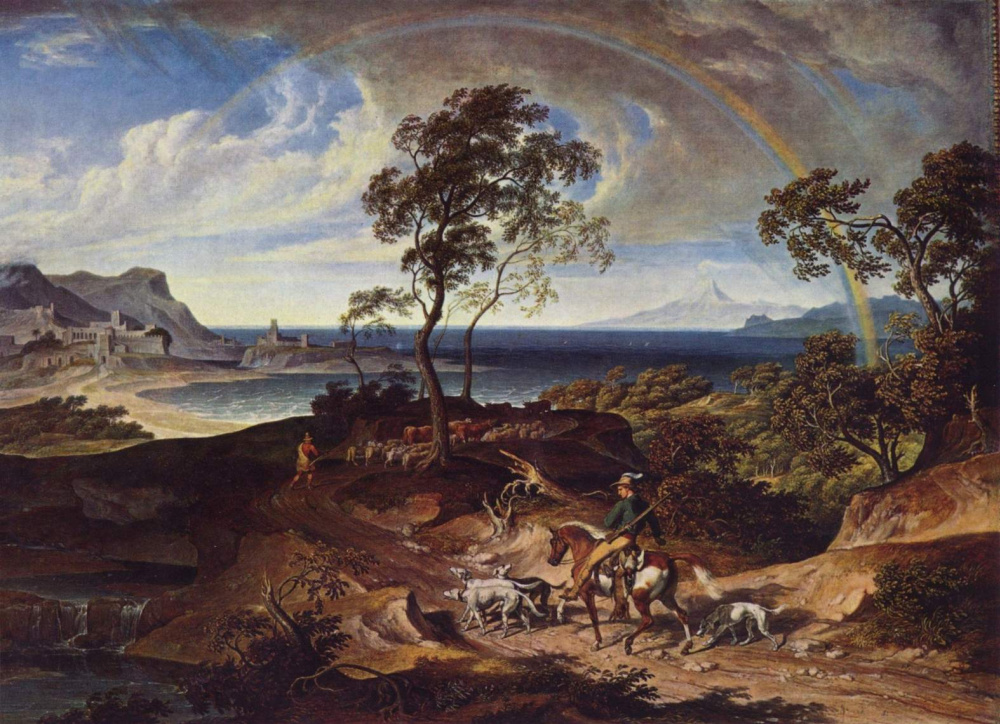Joseph Anton Koch, forefather of the Hausmann and Frielingsdorf families
The Hausmann and Frielingsdorf families in Rome are the descendants of the Austrian painter Joseph Anton Koch. He settled in Rome at the beginning of XIX Century, becoming a leader of the Deutsch-Römer, the community of the German people who lived in Rome during the Pope Kingdom.

His personal life and artistic work are a good representation of the connection between the German culture, originating in Austria, in the German states or in Prussia, and the Italian cultural environment. A phenomenon which foreshadows Europeism in its essence of merger of cultures and mutual enrichment, despite it originated in years when States and Kingdoms were variable, even temporary. A phenomenon that teaches us that European Union is not only a political project, yet the result of the pushing of the European cultures to merge and enrich reciprocally, as they demonstrated to be able to do starting at the age of the antique Greece.
The experience of Joseph Anton is much deeper and longer compared to the fast bath in the Italian culture and beauty that many European artists used to take in the beautiful cities and landscapes of Italy. He was among the few foreign artists that elected Italy as his homeland, taking wife and settling down until his death. And the only one that left a copious progeny, no more German yet truly Roman.

Joseph Anton Koch was born in 1768 in a small village in the Austrian Tyrol, named Obergiblen. He was one of ten between sons and daughters of a farmer. At his young age, Joseph Anton helped his father as a sheepherder. He had a lot of free time that used to express his artistic talent, painting the pastoral landscapes he lived in.
His talent was noticed by the Augusta Bishop Clemente Venceslao. The Bishop offered to Joseph Anton to study. Firstly, in a Seminary, after in the workshop of a sculptor in Augusta and, finally, in the Karlsschule in Stuttgard, a military academy where Joseph Anton studied from 1785 to 1791. In that year he left the boarding school to join the revolutionary movements that were raising in Strasburg and Basel, following the ideas of the French Revolution. Joseph started a 3-years travel without destination across the Swiss Alpes. In those 3 years he designed the landscapes he lived in, building a drawing portfolio that he will use in the future years, often as a background of new paintings.
The help of a patron allowed him to finally get to Italy, at the end of 1794, after passing the Alpes footpath. He visited the most famous places in Italy: Bologna, Florence, Neaples and Salerno, showing a true love for Italian painting.
He arrived in Rome in 1795. He quickly integrated in the Deutsch-Römer circle, made of the German living in Rome when the city was still the capital city of the Papal States, becoming undisputed referral point for all the German artists in town.
Together with his friends, Joseph Anton was regular at the Caffè Greco, an historical bar located in the central via dei Condotti, established in 1760 and elected as hangout for the German community in Rome. A portrait of Koch is still hanged to the walls of the Roman café.

In this cultural cradle grows the art of Joseph Anton Koch. Starting from the first years of XIX Century he painted the Roman countryside, with a special love for the oak forest at Serpentara and the Olevano Romano village. In Olevano he found a wife, Cassandra Ranaldi, daughter of a wine producer. Joseph Anton and Cassandra had three sons, among them Augusto, who was a painter and father of Gaetano Koch, that will be a famous architect at the end of the Century.
Koch’s style is tied to the Neoclassicism of his master and friend Carstens. It reflects a deep knowledge of the Italian style, specifically of the human bodies designed by Michelangelo and of the landscapes of Annibale Carracci. Subjects are mainly religious or mythological, settled on the landscape of the Roman Countryside, or taken from the Dante’s Divina Commedia.
Napoleon’s occupany brought Joseph Anton to move to Wien, together with his wife and daughter Elena, in 1812. The Koch lived in Vienna for three years, without being able to become familiar with the city and the local rigid weather. The hard time in Wien was an inspiration for Koch’s work: he painted in Austria some of its most beautiful Italian landscapes, generating a strong influence over the new generation of Austrian romantic artists.

In 1815 the Koch family was back in Rome. The Prince Ludwig, that lately became King Ludwig I of Bavaria, habitual visitor in Rome, supported economically Joseph Anton and the German artists community: he bought several paintings and gave to the artist the possibility to use Villa Malta as a place of meeting and work.

It is in 1819 that Koch worked on the paintings he believed his most important work. Being so appreciated for Dante’s illustration, he was elected by the Prince Massimo to paint some frescos inside the Casino of Villa Massimo, having the “Divina Commedia” as a subject.

Even though his production was very appreciated by his colleagues, his life was never rich and comfortable. King Ferdinand I of Austria helped him with a generous pension, that unfortunately arrived a few months before Joseph Anton died, in 1839.

Koch was buried in the Teutonic Cemetery, the cemetery dedicated to German people living in Rome inside the Vatican City State, below the shadow of Saint Peter’s dome.

The strong integration between Koch and Italy is evident in its descendants. Sons and nephews of his first daughter Elena live in Germany, Switzerland, Spain, even in Brazil and Australia, but in the majority still live in Rome. Among them we find the Bretschneider, Hausmann, and Curti Gialdino families. The Hausmann and the Curti Gialdino families gave two of their sons to Italy, during the War. The two masculine sons of Joseph Anton, Camilo and Augusto, married in Rome two girls from a noble family from Lecce. Augusto, a talented painter, is the forefather of all the Koch still living in Rome. Some of them still having the artistic genius of the grandfather, such as one of the sons of Augusto, the architect of the King Umberto’s Rome that designed the current Bank of Italy building and the United States Embassy in Rome. Some other excelled in the professions, such as the Lodoli, in economical activities or in public services, such as the Koch Italian diplomatic among three generations.
In 2011 the Goethe House in Rome held an exhibit dedicated to Joseph Anton Koch’s work, in the building at 18, via del Corso, so close to the stores of the modern Hausmann & Co. Company. The show, entitled “Joseph Anton Koch in Rome. Designs from the Kupferstichkabinett from Wien”, showed a collection of work coming from Wien.






























